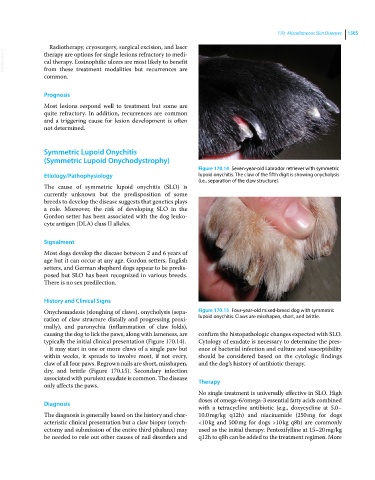Page 1567 - Clinical Small Animal Internal Medicine
P. 1567
170 Miscellaneous Skin Diseases 1505
Radiotherapy, cryosurgery, surgical excision, and laser
VetBooks.ir therapy are options for single lesions refractory to medi-
cal therapy. Eosinophilic ulcers are most likely to benefit
from these treatment modalities but recurrences are
common.
Prognosis
Most lesions respond well to treatment but some are
quite refractory. In addition, recurrences are common
and a triggering cause for lesion development is often
not determined.
Symmetric Lupoid Onychitis
(Symmetric Lupoid Onychodystrophy)
Figure 170.14 Seven‐year‐old Labrador retriever with symmetric
Etiology/Pathophysiology lupoid onychitis. The claw of the fifth digit is showing onycholysis
(i.e., separation of the claw structure).
The cause of symmetric lupoid onychitis (SLO) is
currently unknown but the predisposition of some
breeds to develop the disease suggests that genetics plays
a role. Moreover, the risk of developing SLO in the
Gordon setter has been associated with the dog leuko-
cyte antigen (DLA) class II alleles.
Signalment
Most dogs develop the disease between 2 and 6 years of
age but it can occur at any age. Gordon setters, English
setters, and German shepherd dogs appear to be predis-
posed but SLO has been recognized in various breeds.
There is no sex predilection.
History and Clinical Signs
Onychomadesis (sloughing of claws), onycholysis (sepa- Figure 170.15 Four‐year‐old mixed‐breed dog with symmetric
ration of claw structure distally and progressing proxi- lupoid onychitis. Claws are misshapen, short, and brittle.
mally), and paronychia (inflammation of claw folds),
causing the dog to lick the paws, along with lameness, are confirm the histopathologic changes expected with SLO.
typically the initial clinical presentation (Figure 170.14). Cytology of exudate is necessary to determine the pres-
It may start in one or more claws of a single paw but ence of bacterial infection and culture and susceptibility
within weeks, it spreads to involve most, if not every, should be considered based on the cytologic findings
claw of all four paws. Regrown nails are short, misshapen, and the dog’s history of antibiotic therapy.
dry, and brittle (Figure 170.15). Secondary infection
associated with purulent exudate is common. The disease Therapy
only affects the paws.
No single treatment is universally effective in SLO. High
doses of omega‐6/omega‐3 essential fatty acids combined
Diagnosis
with a tetracycline antibiotic (e.g., doxycycline at 5.0–
The diagnosis is generally based on the history and char- 10.0 mg/kg q12h) and niacinamide (250 mg for dogs
acteristic clinical presentation but a claw biopsy (onych- <10 kg and 500 mg for dogs >10 kg q8h) are commonly
ectomy and submission of the entire third phalanx) may used as the initial therapy. Pentoxifylline at 15–20 mg/kg
be needed to rule out other causes of nail disorders and q12h to q8h can be added to the treatment regimen. More

